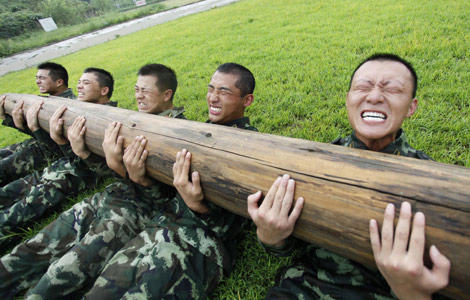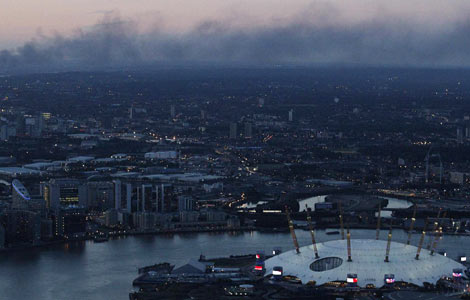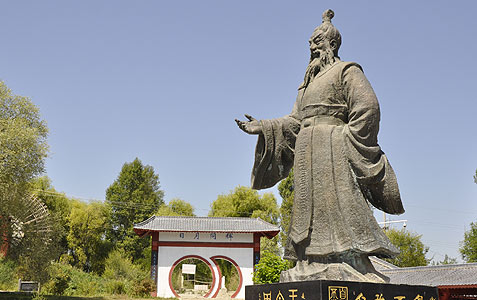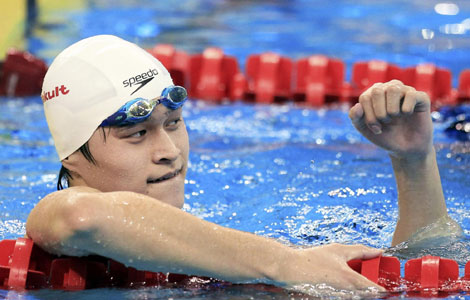China's refitted aircraft carrier starts sea trial
Updated: 2011-08-10 07:58
(Xinhua)
|
|||||||||||
|
![China's refitted aircraft carrier, file photo. [Photo/Xinhua] China's refitted aircraft carrier starts sea trial](../../images/attachement/jpg/site1/20110810/0013729e48090fac082306.jpg) |
|
China's refitted aircraft carrier is seen in this undated file photo. [Photo/Xinhua] |
DALIAN - China's first aircraft carrier set out on a low-profile sea trial Wednesday, its first journey under the Chinese flag. The vessel was swaddled in mist as it departed the port of Dalian, which had narrowly escaped tropical storm Muifa Monday.
Military sources said that the trial is in line with the carrier's refitting schedule and will not take a long time. Refitting work will continue after the vessel has returned to the port.
The People's Liberation Army (PLA) Navy behemoth is a former Soviet Navy aircraft carrier, which has been totally refitted for its new role as a platform for research and training.
"Anyhow, it's an object of pride," said a shipbuilding worker who identified his surname as Zhang, who worked on the ship's hull, stayed up all night to watch the carrier began its first sea trial.
The carrier departed from the Dalian shipyard where workers have been refurbishing the ship. Dalian is some 80 nautical miles north of the sea battlefield where 117 years ago the first modern Chinese navy fleet was ferociously bombarded and later vanquished by the Japanese navy.
It is still unknown where or for how long the carrier's first sea trial will last.
The Liaoning Provincial Maritime Safety Administration publicized a notice restricting navigation in waters off the Dalian coast, saying that vessels are forbidden from traveling through an area of sea 13.25 nautical miles wide and 22 nautical miles long in the northern Yellow Sea and Liaodong Bay from August 10 to 14.
"GREEN HAND"
The ship, formerly named Varyag, is an Admiral Kuznetsov Class aircraft carrier that is 304.5 meters long and 37 meters wide, with a displacement of 58,500 metric tons. Construction on the vessel was started by the Soviet Union in 1985. It was completed in 1992 except for its electronic components.
After the Soviet Union broke up in 1991, Ukraine took over the ship. In 1998, the vessel was bought by a Macao casino company in open bidding. Since March 2002, it has quietly berthed in the port of Dalian with its hull and deck painted PLA Navy grey. After arriving in Dalian, images of the ship were spread across the Internet.
The Chinese Defense Ministry responded slowly to speculation about China having an aircraft carrier despite widespread dissemination of snapshots of the ship. On July 27, the Ministry confirmed China's aircraft carrier program, while emphasizing the carrier was only intended for "scientific research, experiment and training."
Currently, the United States, the United Kingdom, France, Russia, Spain, Italy, India, Brazil and Thailand, operate a total of 21 active-service aircraft carriers.
Japan's Maritime Self-Defense Force currently has two 18,000-metric ton Hyuga-class helicopter carriers, although the warships are classified by Japan as "helicopter destroyers."
Compared with countries who had decades of experience of operating aircraft carriers, China is really a green hand, said Cao Weidong, a researcher with the People's Liberation Army (PLA) Navy's Academic Research Institute.
Naval strategist Yin Zhuo said in an interview with Xinhua, "It usually takes at least ten years to build up a strike group centered on an aircraft carrier, which is just an initial step for shaping marine defense capacity."
Senior Colonel Chen Zhou, a war theorist working for a key PLA think tank, said he didn't believe development of aircraft carrier battle groups means China is making a shift in its naval strategy from offshore defense to anywhere else.
"Even well before the unveiling of the first aircraft carrier," Chen said, "China did not hide its intention to improve its navy, which is still quite weak in defense capability."
MORE SYMBOLIC SIGNIFICANCE
Amid rumors the ship was preparing to go to sea, swarms of spectators -- not all military fans -- flew to Dalian this week to get a view of the conventionally fueled ship, as well as participate in a summer beer fest in the city. Global journalists, including at least one crew from Japan, also gathered nearby to do interviews or shoot footage of China's first aircraft carrier.
Now that China is the world's second largest economy and is playing a more active role in multinational diplomacy, the pick of a disarmed Russian vessel as China's first aircraft carrier seems somewhat low-key.
"It isn't a big deal for China to have an aircraft carrier. It is in the state's interest," said Tan Changbin, a tourist from southwest China's Sichuan Province.
Military enthusiast Lu Gang who came to Dalian to see the carrier said he believed the carrier carries more symbolic significance than anything else.
"It is very complicated to refit an aircraft carrier. It is a challenge to upgrade the country's industrial manufacturing ability," he said.
China became the world's No 1 shipbuilding country in terms of vessel's tonnage in 2010, surpassing Japan and the Republic of Korea.
Xu Jian, a retired navy officer, said China's international status implies that the country deserves to have its own aircraft carrier.
"Even countries like India and Thailand have carriers, let alone America and Russia. Why can't China?" he asked.
Zhou Xiangling, a researcher with the Dalian Institute of Modern History, said the carrier's sea trial signifies a new era for China's navy.
"It implies that China is able to make new contributions to maintaining global maritime safety and peace," he said.
To fuel its fast growing economy, China is increasingly reliant on natural resources imported through maritime transport routes from overseas.
While conducting escort operations in the Gulf of Aden and waters near Somalia since the end of 2008, warships of the PLA Navy have protected thousands of Chinese and foreign civilian vessels alike.
The Chinese navy is made up of three separate fleets: the Beihai Fleet, the Donghai Fleet and the Nanhai Fleet. Each fleet has its own support bases, flotillas, maritime garrison commands, aviation divisions and marine brigades.
"NO EXCESSIVE WORRIES"
The Pentagon welcomed the PLA's public mention of its first aircraft carrier, calling it a step toward better transparency between the Pacific powers.
In July, the PLA invited US Navy Admiral Mike Mullen, chairman of the US Joint Chiefs of Staff, to visit a submarine base and a battle unit of the Second Artillery Force, which is charged with handling China's nuclear stockpile.
Kent Calder, a veteran China hand at the Johns Hopkins University, said in an email interview with Xinhua, "I have thought for many years that China would develop aircraft carriers due to the rising importance of energy sea-lanes to the Middle East."
"That does not in itself, however, represent a surprising or major change in the strategic equation (in Asia Pacific), particular with the United States," Calder said.
Sun Zhe, a Beijing-based Tsinghua University international relations professor, said the aircraft carrier would be no more than "the first step for future development."
The Voice of Russia once speculated that two home-grown Chinese aircraft carriers might be built at a Shanghai shipyard. A recent Kanwa Defense Review article said Shanghai-based Bao Steel is able to manufacture the corrosion-resistant steel needed for an aircraft carrier.
At a joint press briefing with Admiral Mullen on July 11, General Chen Bingde, chief of the PLA General Staff, said China has not yet decided how many aircraft carriers the country is going to build.
Still, some neighboring countries have expressed concern over the ever-increasing strength of the Chinese armed forces. Japan's most recent defense white paper noted the growing "assertiveness" of China's military buildup.
"A major Chinese decision to move forward with a blue-water navy including aircraft carriers would encourage a deepening of Japanese concerns, since the sea-lanes through the South China Sea are vital to Japan's energy security," Calder said.
Arguing that such concerns are unnecessary, Senior Colonel Chen said, "The PLA defense philosophy rules out possibilities of preemptive strikes."
"We will not attack unless we are attacked; we will counterattack if we are attacked," he said.
Senior Colonel Geng Yansheng, the ministry's spokesman, said that China's carrier program will not change the defensive nature of its national defense policy.
With vast territory and a long-time farming culture, China has long had a land-locked mindset. Even with over 18,000 kilometers of coastline, imperial dynasties long banned maritime commerce for fear it would threaten China's largely self-sufficient economy and rigid social fabric.
The devastating defeat in 1895 of the Qing Dynasty's well-funded Beiyang Navy to Japanese naval fleets awakened Chinese politicians. Even the most sophisticated ironclad vessels bought from Germany and Britain did not stop the Japanese attacks, which ultimately resulted in a humiliating bilateral treaty.
From the Opium War in 1840 to the founding of the People's Republic of China in 1949, China suffered more than 470 offenses and invasions that came from the seas.
Two other decommissioned aircraft carriers have also been bought for use in China. However, the Soviet-made Minsk and Kiev, were remolded into big recreational facilities and tourist attractions, with Western-style restaurants, Russian dance shows, night clubs and guest rooms.
"The objective of the current Kiev carrier theme park is to enhance visitors' awareness of national defense and world peace," said Liu Weidong, deputy general manager of the Tianjin Binhai Aircraft Carrier Theme Park.
According to Liu, tens of thousands of tourists from China and abroad visited the theme park each year, which is stationed at a dock about 80 kilometers east to downtown Tianjin.
Liu Bing, a 32-year-old visitor to the Kiev theme park with six family members, told Xinhua that he believed the rifetted carrier in Dalian is just a starting step for China.
"The carrier will show China is a peace-loving country, which is the last among the permanent members of the UN Security Council to possess an aircraft carrier," he said.
Hot Topics
Anti-Gay, Giant Panda, Subway, High Speed Train, Coal Mine, High Temperature, Rainstorm, Sino-US, Oil Spill, Zhu Min
Editor's Picks

|

|

|

|

|

|







